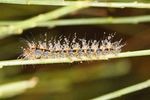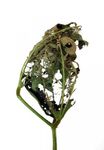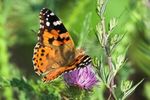THISTLE CATERPILLAR - Soybean Research and Information Network
←
→
Page content transcription
If your browser does not render page correctly, please read the page content below
THISTLE CATERPILLAR
Soybean Pests
Overview
The thistle caterpillar, Vanessa cardui, is the larva of the adult painted lady butterfly. It takes
its name from the Canada thistle, which is a preferred host. It is considered a sporadic pest
of soybean. Larvae have a wide host range that includes over 300 plant species.This pest does not overwinter in northern growing areas but migrates up from southern
states and Mexico each spring. Eggs are laid singly on the upper side of leaves of host
plants, including Canada thistle, sunflower, and soybean. Caterpillars hatch and form webs
by tying leaves together with silk, which creates a protected area for them to feed in.
Caterpillars feed on leaves causing defoliation in the upper canopy of the soybean plant.
After two to six weeks, they form a chrysalis, which hangs from the host plant. After seven to
10 days, the butterfly emerges. There are two generations per year in the Midwest but there
may only be one in more northern production areas.
Scouting
Adults (Figure 1)
Upper side of front wings are red–orange and brown, with black and white spots.
Hindwings are red–orange and brown, with four black “eye spots” along the edge.
Figure 1. Adult painted lady butterfly.
Eggs
Eggs are light green and barrel–shaped.Caterpillar/larva (Figure 2)
The brown to black body is one and one-fourth inches long and has yellow striping on
both sides.
Branched, spiny hairs covering the body give the caterpillar a prickly appearance.
Caterpillars form a webbing in the leaves where they feed.
Figure 2. Painted lady (thistle) caterpillar. Photo: University of Nebraska – Lincoln,
CropWatch
Thistle caterpillars tend to aggregate toward the field edges, especially if there is Canada
thistle present along the edges.
To estimate percent defoliation, examine a minimum of 10 plants:
1. From each plant, select a leaf from the top, middle and bottom third of the plant.
2. Use Figure 3 to estimate percent defoliation for each leaf and calculate the average
percent defoliation across the three leaves from each plant and then across the
multiple plants.
3. This average percent defoliation for the field’s canopy can be compared to treatmentthresholds. Figure 3. Levels of soybean defoliation. Injury is often overestimated. CropWatch – University of Nebraska – Lincoln Treatment Thresholds for Caterpillars in Soybeans In vegetative (pre-flowering) stages, consider treatment if the insects are present and feeding, and defoliation will exceed 30%. In pod-forming or pod-filling stages, consider treatment if the insects are present and defoliation will exceed 20%. This normally requires about 8 to 10 caterpillars per foot of row. If plants are still small, then best judgement may have to be made. One reference suggests a treatment guideline of 3 larvae per row foot in young soybeans, another when damage is severe and plants are being killed. Keep in mind, other foliar feeding insects including soybean looper, green cloverworm and grasshoppers may be feeding at the same time and defoliation damage is cumulative among the pests present. Insecticide treatments Several foliar insecticides labelled on soybeans have activity against these and other caterpillars. Consult your state Extension office for recommended products and rates. Always read and follow label directions for use.
This website is funded by the soybean checkoff
©2022 Soybean Research & Information Network
Powered by TCPDF (www.tcpdf.org)You can also read

























































